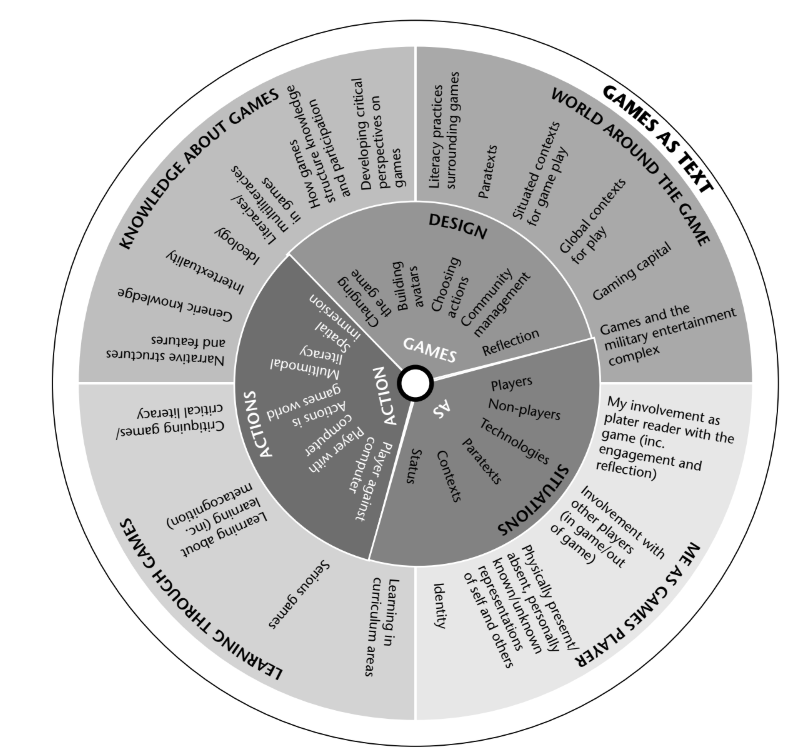Activity 1: Foundations of Digital Games and Learning
Jamie Drozda and Melanie Laurie
In Serious play: Literacy, learning and digital games, Beavis, Dezuanni and O’Mara (2017) clearly illustrate how digital games can be incorporated into the classroom. Our focus was on how the teacher’s experience with games and their personal approach to teaching determine how digital games are utilized for student learning. We noticed that the perceived value of games and play differs among teachers, and this can greatly impact which games a teacher may choose to use or how they design the learning experiences around the games. We also noticed that learning through games looks and sounds different than typical classroom learning. Sometimes, this can provide motivation for teachers to change their perception of games and their pedagogy, which ultimately leads to the creation of a more engaging learning environment.
In Chapter 5, Curating The Curriculum With Digital Games, Dezuanni and Zagami discuss “curatorship as a concept” (Dezuanni & Zagami, 2017, p. 67) to find out how teachers utilize digital games to bring together their curriculum. Curatorship comes from the word curator which is defined as “one who has the care and superintendence of something especially: one in charge of a museum, zoo, or other place of exhibit” (Merriam-Webster, n.d.) Education Curators are a little different since we do not have responsibility for a collection of physical things, therefore we have care and superintendence of delivering curriculum to students. “Dezuanni and Zagami take up the notion of ‘curatorship’, and ‘the consequences of curriculum curation with digital games when classroom and pedagogic practices change gameplay in unintended or unexpected ways’.” (Beavis, 2017, p.12) They bring forward four examples of how teachers use digital games to provide new ways of learning and provide details of the changes that were made to pedagogic practices. Listen to audio tracks below to learn about each example.
Example 1: Curating English Curriculum in Year 3 Using Minecraft
Example 2: Curating Physics Experiences With Digital Games for Year 4/5 Science
Example 3: Curating Social Capital Knowledge in Year 8 Studies of Society and Environment With Statecraft X
Example 4: Curating Ethical Dilemmas in Year 9 Religious Education with Secret Agent: Mission One
Chapter 5 brings together several examples of how teachers use their expert curricular knowledge to bring together digital games, physical spaces and curriculum to provide a rich learning environment for students.
In Chapter 6, The Non-Gamer Teacher, The Quiz and Pop Teacher and The Kinect Teacher, Prestridge focuses “on why and how teachers use games and the effect this has on their own perceptions of who they are as teachers in the twenty-first century.” (Prestridge, 2017, p. 87) Prestridge brings forward the experiences of three teachers as they venture with the implementation of digital games in their classrooms. Prestridge outlines four generative categories “to think about how teachers respond to new experiences and adjust (or not) their pedagogies accordingly” (Prestridge, 2017, p. 86) and applies the generative categories to teachers in three case studies. These categories are the:
-
- “Contented Traditionalist” – a teacher who does not stray from the prescribed curriculum and assessment requirements and who takes a traditional approach when selecting technologies for the classroom
- “Selective Adopter” – a teacher who strays from the prescribed curriculum and assessment requirements yet takes a traditional approach to choosing technologies for the classroom.
- “Creative Adapter” – a teacher who takes a student-centered approach to teaching and learning
- “Inadvertent User” – a teacher who uses technology when it is prescribed
(Prestridge, 2017, p. 88)
Prestridge explores three case studies that provide insight to the teachers’ professional development and refinement of their pedagogical beliefs pertaining to digital game. Listen to the audio tracks below to learn about each case study.
Case Study 1: Lucy: the Non-Gamer Teacher, Contented Traditionalist to Creative Adapter
Case Study 2: Malcolm: the Quiz and Pop Teacher, Selective Adopter
Case Study 3: Janet: the Kinect Teacher, Creative Adapter
The case studies in Chapter 6 show that in the beginning teachers will use digital games according to their pedagogical beliefs. The challenges teachers and students face will shape the changes that follow. It is through trial and experimentation that new understandings are made. It is important that educational leaders support teachers in their endeavors with technology so they can use digital games to create authentic learning opportunities that align with how the “new generation” learns.
In Chapter 9, Beavis et al. explore the textual and actionable nature of games in the context of literacy. They assert that gaming literacy is an important concept that should be considered by educators as the world integrates more into the digital world, especially with any English or literacy curriculum. Because games need to be played, they uniquely require the designer and player to understand how text and action are integrated to form meaning. Chapter 9 describes how the Games as Text, Games as Action Model (created by Apperley and Beavis, 2013) influenced teachers in how they utilized games in their units of study.

(Apperley & Beavis, 2013, as cited by Beavis et al., 2017)
Listen to the audio tracks below to learn about three instances of the model’s influence.
Instance 1: Jacinta – Games as Text
Instance 2: Janet – Games as Action
Instance 3: Nick – Games as Design
The Games as Text, Games as Action Model provided these teachers a framework to consider the affordances of digital games. Though its impact varied between the teacher, each of them were able to recognize what literacies can be learned through games.
Throughout this book, Beavis et al. (2017) note how important the role teachers play in facilitating learning through games. They state that “it was not the games themselves, but what teachers did with them that made deep learning possible” (p. 221). Teachers’ ability to pair the curricular goals with the interactivity and multimodality of digital games sets the context for students to make meaning, whether it be through observation, design or gameplay. The accounts and themes shared by Beavis et al. (2017) provide a wide scope of how teachers can use games to enrich learning and to develop skills that students need for their “participatory culture” (Jenkins et al., 2009, as cited in Beavis et al, 2017, p. 23).
References
Beavis, C., Prestridge, S., & O’Mara, J. (2017). Games as text and games as action: English, literacy and digital games. In Beavis, C., Dezuanni, M., & O’Mara, J. (Eds.). (2017). Serious Play. New York: Routledge, https://doi-org.ezproxy.library.ubc.ca/10.4324/9781315537658.
Dezuanni, M., & Zagami, J. (2017). Curating the curriculum with digital games. In Beavis, C., Dezuanni, & M., O’Mara, J. (Eds.). (2017). Serious Play. New York: Routledge, https://doi-org.ezproxy.library.ubc.ca/10.4324/9781315537658.
Merriam-Webster (n.d.). Retrieved January 10, 2020, from https://www.merriam-webster.com/.
Prestridge, S. (2017). The non-gamer teacher, the quiz and pop teacher and the kinect teacher. In Beavis, C., Dezuanni, M., & O’Mara, J. (Eds.). (2017). Serious Play. New York: Routledge, https://doi-org.ezproxy.library.ubc.ca/10.4324/9781315537658.
